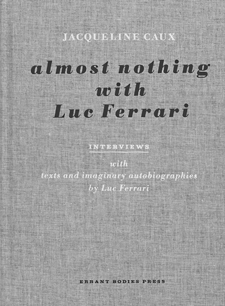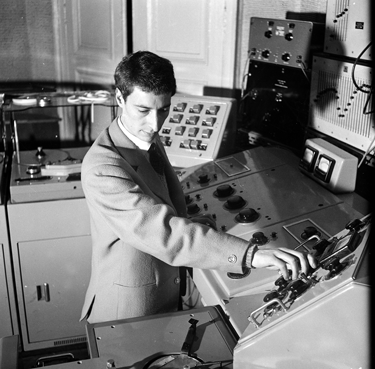Hardcover, 2013, ISBN 978-0-9827439-1-1, 176 pages, US$ 22, translated into English by Jerome Hansen, available from Errant Bodies Press, Kollwitzstrasse 97, 104535 Berlin, Germany, www.errantbodies.org.
Reviewed by Curtis Roads
Santa Barbara, California, USA
 This handsomely printed 176-page hardcover edition by the publisher Errant Bodies Press translates Jacqueline Caux’s inspired French edition, which appeared in 2002. French composer Luc Ferrari was born in Paris in 1929 and died unexpectedly in 2005 while traveling through Italy. He studied piano with Alfred Cortot, musical analysis with Olivier Messiaen, and composition with Arthur Honegger. He was a veteran of the Darmstadt Summer Courses where he met all the main European composers of the day.
This handsomely printed 176-page hardcover edition by the publisher Errant Bodies Press translates Jacqueline Caux’s inspired French edition, which appeared in 2002. French composer Luc Ferrari was born in Paris in 1929 and died unexpectedly in 2005 while traveling through Italy. He studied piano with Alfred Cortot, musical analysis with Olivier Messiaen, and composition with Arthur Honegger. He was a veteran of the Darmstadt Summer Courses where he met all the main European composers of the day.
In 1954, Ferrari traveled the Atlantic via freighter to meet Edgard Varèse in New York, whose Déserts he had heard on the radio. Meeting Varèse made a huge impression on the young Ferrari. By 1958 he was a founding member of the Groupe de Recherches Musicales (GRM) with Pierre Schaeffer and François-Bernard Mâche.
One of the key characteristics of Ferrari was his artistic range. Besides an extensive catalog of instrumental music for piano, string quartet, various ensembles, and orchestra, he made films, scored many soundtracks, mounted theatrical productions, composed radiophonic works, and designed sound installations. Although best known for his musique concrete work, Pierre Schaeffer ostracized when his work Presque rien no. 1 (1970) pushed the boundaries of that genre toward the direction of soundscape. In the last decade of his life he collaborated with young DJs, further indication of his iconoclastic position. The use of ambient field recordings was a distinctive part of Ferrari's musical language. He was always recording and built a huge sound archive. When I met him at the train station in Santa Barbara he stepped out of the train wearing headphones with a stereo microphone in his hand.
In French culture, the general rule is that an artist stakes out an aesthetic position, a line, and a corresponding style and stays with it. Most composers attach to an existing line, like the “IRCAM line”, the “GRM line”, etc. Ferrari confounded those who tried to pigeonhole him. He reveled in testing completely new directions, creating lines that no one knew could exist. As a result, it is difficult to summarize his oeuvre or classify him. But he paid a price for his independence from established lines. As Jacqueline Caux observes:
Luc Ferrari took part in all the insurgent strongholds, all the musical ideologies of the second half of the twentieth century, and still managed to get away unscathed. In the contemporary music world, no one quite knows what to make of this “offbeat” composer who seemingly strived to appear light, frivolous, and nonchalant, whereas on the contrary each of his works is an invitation to reflection for the attentive listener.
 In it worth noting that John Cage had little impact in France, with the exception of Ferrari, who felt a special affinity to Cage, especially the absurdist and humorous side of his music. Indeed, one might think of Ferrari as the better-dressed French counterpart to Cage.
In it worth noting that John Cage had little impact in France, with the exception of Ferrari, who felt a special affinity to Cage, especially the absurdist and humorous side of his music. Indeed, one might think of Ferrari as the better-dressed French counterpart to Cage.
My first encounter with Ferrari began through a shotgun marriage of two new music centers arranged by the French Ministry of Culture: Les Ateliers UPIC (where I worked) and La Muse en Circuit, which Ferrari had co-founded. I had long admired his work, and to me, Luc and Brunhild Ferrari were artistic royalty. I had many discussions with Ferrari during my years in Paris (1991-1996) and during his visits to Santa Barbara in 1997 and 2002. Thus, I am familiar with the themes of this book.
Caux divides the book into seven chapters: Introduction, History, Instrumental Compositions, Music Theater, Radio Art: Hörspiel, Installations, Concepts, and a Catalogue. Each chapter’s form is idiosyncratic, usually consisting of comments by Caux or an interview with Ferrari, interjected by often long observations by the composer in the form of diary entries, program notes, or mini-autobiographies. Through this unusual literary form we come to know the motivations behind Ferrari’s obsessions with anecdotal material, intimate personal spaces, autobiographical references, chance, looping, tautology, narrative, artificial sonic landscapes, and the heterogeneity of simultaneous content.
Astonishingly, when he died, no obituary for Ferrari appeared in American newspapers. Thus this book fills the need for a concise introduction to the man for the English-speaking world. My only quibble with the publication is the lack of an index.